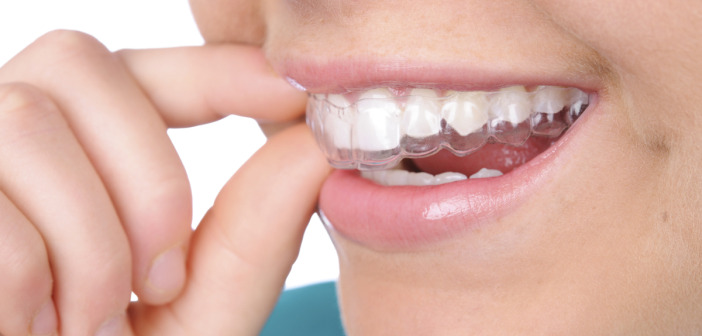Invented in 1997 and approved for use in the US by the Food and Drug Administration in 1998, Invisalign is a popular treatment procedure for straightening the teeth. It is available widely and designed as an alternative to traditional, sometimes-painful wire braces.
How Does Invisalign Work?
Instead of the usual metal brackets attached to the teeth and connected to each other by metal wires, Invisalign uses transparent aligners that fit entirely over the teeth in a manner similar to anti-grinding mouthguards. The aligners are adjusted in increments over time so the teeth are gradually pushed into the correct, medically-recommended position.
The popularity of Invisalign is easy to understand, particularly among older/ adult patients who may not want to undergo a treatment as visible as metal braces. While the cost of Invisalign tends to run higher than that of traditional braces, the benefits of a procedure that doesn’t have such an obvious effect on the patient’s appearance often outweigh the increase in price.
Pain of Invisalign Versus Metal Braces
Many people considering Invisalign wonder about other benefits it may have as well. One of the most commonly-asked questions is whether Invisalign causes the patient the same amount of pain as traditional braces.
As anyone who has undergone metal dental braces can attest, the application, wearing, and adjustment of the brackets over the course of time can add up to a lot of discomfort. Patients who aren’t willing or eager to put themselves through that may very well consider Invisalign and wonder if it’s a less painful alternative.
We talked with Prior Family & Cosmetic Dentistry about this question and they added, “The answer to this question, as with many questions concerning dental procedures, is that the level of pain associated with it will vary depending on the patient, his or her dental conditions, and his or her definition of what is painful. With that said, one of the main selling points of Invisalign is the fact that the system was designed not only to be less conspicuous, but also to be less painful than traditional metal braces.”
The nature of the system itself, i.e. the use of the aligners rather than brackets and tightened wire, generally means:
– While the adapters can cause temporary irritation and discomfort due to friction against the tissues inside the mouth, in general this issue is less of a problem with Invisalign than with the metal brackets of traditional braces.
– The process of adjusting Invisalign is done via the replacement of the aligner tray with another one set to different specifications. In contrast, metal braces are adjusted by a tightening of the wires between each tooth bracket. While a patient should expect to experience some discomfort when first wearing the Invisalign tray, and again each time the tray is replaced for one with new specifications, the discomfort tends to be less because the movement taking place is less drastic than that caused by tightened wires.
– Invisalign trays are meant to be removed at certain times of the day, including when the wearer is eating or brushing the teeth. In total, the trays are worn for approximately 20 hours per day. This can reduce the pain caused by adjustments to the aligners, as it gives the teeth a chance to rest and prevents the constant ache of the 24/7 pressure caused by the wires of braces.
– Since Invisalign aligners are removed for brushing and flossing, they do not cause the restrictive issues for hygiene often caused by metal braces. This alone can reduce dental pain. Many wearers of traditional braces experience tenderness and pain of the gums, as it’s more difficult for them to successfully floss and clean in every area of the teeth due to the braces. By allowing for consistent hygiene, Invisalign can cut out at least some of the pain problem of swollen or irritated gums or cavities.
Choosing a Treatment Method
Invisalign is not necessarily a feasible, or correct, treatment method for everyone. In cases where the patient’s bite is out of alignment, for example, or where other issues such as misplaced teeth may be contributing to the problem of crooked teeth, braces or other procedures may be the better, more helpful solution.
For some patients, however, Invisalign can indeed be a beneficial alternative method of correction. Those who are wondering if Invisalign would be useful for them should discuss their options with a qualified dental professional.




